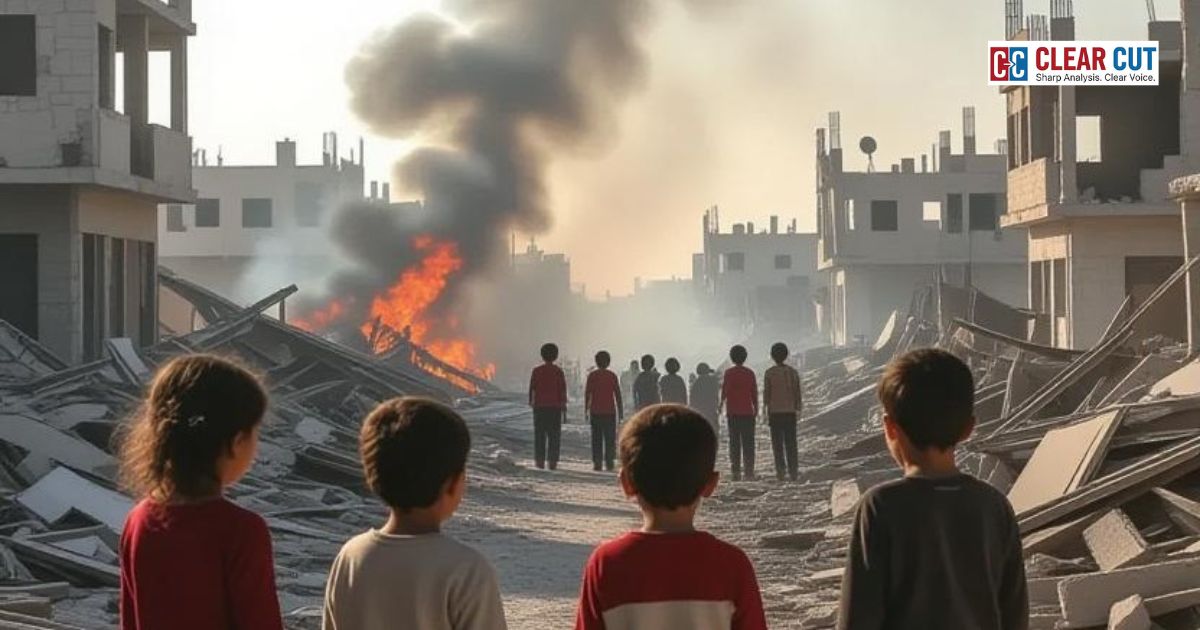Photo Credit: Antara Mrinal
Clear Cut Child Protection Desk
New Delhi, UPDATED: Sep 19, 2025 04:52 IST
Written By: Antara Mrinal
The number of minors caught in the crossfire is at an all-time high. The UNICEF report “Not the New Normal” (end-2024) estimates that in 2023 over 473 million children (more than 1 in 6 children in the world) lived in regions experiencing armed conflict (UNICEF). As of the end of 2023, UNICEF estimates that there are 47.2 million conflict and violence-driven displaced children. Almost 19.1 million children, along with dozens of millions more, are refugees or asylum seekers, which are stateless. They fall under United Nations High Commissioner for Refugees (UNHCR) restrictive definition of refugees and are considered undifferentiated internally displaced persons (UNICEF DATA). According to the Peace Research Institute Oslo, the numbers have grown from roughly 10% in the 1990s, to nearly 19% today.
How Conflict Impacts Children: Lives Disrupted
Like any other problems, conflict zones do not just start and finish within an area, and children suffer the consequences more often than the others. UNICEF and media such as Al Jazeera state that millions of children become evicted, landless, and dispossessed trapped in poverty and within inadequate housing. In just 2023, over 52 million children in countries touched by conflict could not go to school because banks, schools, and educators fled and schools were turned to battlegrounds (UNICEF and The Guardian). Education became one of the first casualties of modern warfare. Health, too, became vulnerable. The conflict spotted the rise of malnutrition due to the collapse of vaccine coverage, unchecked spread of epizootics and the hunger pandemic (The Guardian). Much worse, there is an organized system of violence. In 2023 the United Nations confirmed 32,990 serious breaches of international law, of which 22,500 children were casualties. UNICEF and The Guardian state that children were sexually abused, forcibly recruited, and systematically executed. Others were targets of military operations, humanitarian assistance was obstructed, and schools as well as hospitals were not spared. All these agglomerated facts portray how conflict zones disrupt children’s safety, health, and hope for the future.
Case Highlights: Where Conflict Hurts Most
Of all the crises a region may face, none leaves children as vulnerable as war. In Gaza, the toll has been catastrophic. Since October 7, 2023, more than 14,000 children have been killed, and over 50,000 have been killed or injured, according to UNICEF and aid groups. The scale of child casualties in just a few months is almost without precedent in modern conflicts. The destruction has not spared Gaza’s schools. A UN-led assessment found that between October 2023 and February 2025, 403 out of 564 school buildings were either directly hit or damaged. Of these, 85 schools were completely destroyed, while 73 lost more than half of their structures, crippling education for an estimated 435,290 students and affecting over 16,000 teachers. Even in brief lulls in fighting, children continued to pay the price. After one ceasefire collapsed, at least 322 children were killed and 609 injured in just ten days, many of them already displaced and living in fragile shelters. Entire families were uprooted, schools became ruins, and the daily reality for Gaza’s children shifted from learning and play to survival and grief.

Across the African continent, the Mozambique, and the Democratic Republic of the Congo, along with Somalia and Sudan, clearly highlight that violence brings with it starvation and a lost future. More than a million children in the DRC alone, due to conflict in the eastern provinces, are utterly and desperately vulnerable to malnutrition due to violence and are non-existent to schooling (Global Data). There have been reports of sudden aggravation in the war in Ukraine, now pointing more fingers at the children. Shocking new data says that in the first three quarters of 2023, more children in Ukraine died as a result of the ongoing bombardments, collapsing infrastructure and other worsen-displacement, than in the entire year of 2024 (Global Data). Undoubtedly, the examples presented from all over the world and wars, emphasize that the real victims are children.
Why It’s Getting Worse
Prolonged Wars are prompted by the changing nature of war. There are children who, once born, will spend their entire lives tethered to a war zone. Such children will, probably, never advance from babble to a verbal understanding of their mother’s language. Children who inhabit the conflict zones are borne in a wretched condition. Not only are the women and children most gravely in need of support, but, paradoxically, they are also the easiest groups for aid agencies to reach, for example, through schools, health clinics, refugee camps, community programs, or maternal-and-child health services. Unlike past wars, in which there were a few zones of physical combat, contemporary conflict is garlanded by violence in the zones of everyday life, and children are at great risk. Oil, food, and humanitarian assistance convoys are regular targets of attack, as are the aid shipments of crammed buses and the medicines loaded on planes. Such children live in a constant state of anxiety and are the most vulnerable to a crisis of food, and rapid economic decline, as well as to the shocks of climate change.
A Generation in Danger
The statistics on the issue is terrifying. The headlines state that millions of people are refugees, tens of millions of children do not go to school, and nearly half a billion children live in war zones. In the worst-case scenarios, these figures demonstrate that when the world moves swiftly and takes rational steps to healthcare and education, safeguarding fundamental freedoms, and reinstating services, misery is averted, wounds are healed, and the future is salvaged. The government, international bodies, NGOs, and financiers need to collaborate to stop the erasure of a generation. And they need to build strong systems that safeguard children and defend their rights even when conflict is imminent.
With Inputs from:
- UNICEF, “Not the New Normal: 2024 One of the Worst Years in UNICEF’s History for Children in Conflict” press release/data.
- Save the Children/PRIO, Children in Armed Conflict Report 2023 / “473 million children live in conflict zones” Peace Research Institute Oslo.
- UNICEF Data on Child Migration & Displacement (2024) UNICEF DATA
- Records of grave violations and conflict-related child rights violations, UNICEF/UN reports.




